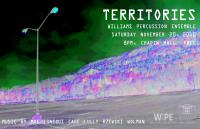
Williams Percussion Ensemble
Sat, November 20th, 2010
9:00 pm
- This event has passed.

Matthew Gold, director
Jean-Baptiste Lully, Marche de timballes (17th cent.)
John Cage, Credo in Us (1942)
Amnon Wolman, Speed Limit Applies (1997)
Alexandre Lunsqui, Entresons.Recreo (2009)
John Cage, Forever and Sunsmell (1943)
Eric Moe, I Have Only One Itching Desire (2006)
Frederic Rzewski, Chains (1986)
The Williams Percussion Ensemble presents Territories, a program whose works probe musical jurisdictions, stake claims, dispute and establish boundaries, put down roots, trespass and plunder, and explore sonic topographies.
In the forward to his Entresons.Recreo (2009), Alexandre Lunsqui writes, “I am very attracted to the idea of music as an environment. I want to create territories and a sense of journey. The listener (traveler) actively discovers his surroundings – the colors, the contours, the temperatures, the elements, and the overall geography.” Entresons.Recreo is scored for six percussionists placed around the audience, each acting as a “virtual source of energy,” creating a diverse sensorial landscape with delicate metals, water, voice, and whistles. The Williams Percussion Ensemble is very pleased to be only the second group to perform this work, and to be giving the East Coast premiere.
Among his many essential contributions to twentieth century music and ideas, John Cage was the great pioneer of music for percussion, and is represented by two works on this program. Credo in Us (1942) is scored for tin cans, gongs, electric buzzer, tom toms, radio, phonograph, and solo piano. While coyly asserting allegiance to a political entity in its title (the Us can also be understood as U.S.), the use of phonograph and radio subverts any clear sense of boundary. By allowing the trespass of sounds that were inconceivable at the work’s premiere in the 1940’s, Cage creates dislocation through the intrusion of temporally and physically unbound music and voices. While the content of any live radio transmission is inherently unpredictable, Cage does specify that the performers should, “avoid news programs during national or international emergencies.” Cage’s other work on the program, Forever and Sunsmell (1943), is a rather simple and lovely setting of a poem by E. E. Cummings for voice and two percussionists, the text hinting at a direct and profound connection to place with lines such as, “the here of this earth… the now of the sky.”
Eric Moe’s I Have Only One Itching Desire (2006) is a supercharged rhythmic eruption built on the processes and practice of West African drumming, overlaid with a drum set solo inspired by Mitch Mitchell, the frenetic drummer of the Jimi Hendrix Experience. Amnon Wolman’s Speed Limit Applies (1997) is scored for a solo speaking percussionist with two assistants. The soloist performs on snare drum and two amplified motor cycle helmets worn by the assistants, while reciting a text by Chuang-tse.
From his privileged position as director of musical activities in the court of Louis XIV of France, Jean-Baptiste Lully pursued numerous compositional innovations, and is widely credited with the introduction of the timpani as a regular member of the orchestra. His Marche de timballes was composed for Louis XIV’s Carousel at Versailles in 1685, and performed by the brothers André Danican and Jacques Danican Philidor, members of the royal musical service.
Born in Westfield, MA, but based in Belgium, composer and pianist Frederic Rzewski has been an innovator in live electronic music and improvisation, and has developed iconoclastic means of incorporating ideas and language into his music as structural elements. Five movements of his work Chains (1986) for voice and any instruments will be performed throughout the program. The vocal soloist performs texts provided by the composer from sources such as Genesis (the book, not the band) and a letter by Christopher Columbus addressed to Ferdinand and Isabella of Spain, as well as incorporating newspaper articles from the day of the performance, accompanied by an ensemble of percussion, trumpet, cello, rocks, brooms, chairs, and tools.
Employing a nearly limitless battery of percussion instruments, the Williams Percussion Ensemble performs cutting edge new music, masterworks of the twentieth century, experimental music, and music from around the globe. Performances feature the use of all manner of percussion instruments as well as homemade objects, found sounds, and electronics. In addition to music for percussion alone, the group presents works for mixed ensembles and new and experimental music for other instruments, and has often worked directly with composers. The ensemble also collaborates with artists in other media in order to explore the connections between different types of sound, form, image, and movement.
Personnel:
- Samuel Austin ’14
- Mark Johnson ’11
- Chaz Lee ’11
- Andrew Lorenzen ’12
- Casey McLellan ’14
- Bryce Mitsunaga ’13
- Eugene Murphy ’13
- Nina Piazza ’12
- Laone Thekiso ’12
Guests:
- Hannah Hindel ’13 – soprano
- Adam Lee ’11 – cello
- Jacob Walls ’11 – trumpet